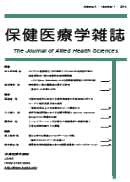Volume 6, Issue 1
Displaying 1-4 of 4 articles from this issue
- |<
- <
- 1
- >
- >|
Original Article
-
2015 Volume 6 Issue 1 Pages 1-9
Published: April 01, 2015
Released on J-STAGE: April 01, 2015
Download PDF (375K)
Original Article
-
2015 Volume 6 Issue 1 Pages 10-14
Published: April 01, 2015
Released on J-STAGE: April 01, 2015
Download PDF (435K)
Review
-
2015 Volume 6 Issue 1 Pages 15-23
Published: April 01, 2015
Released on J-STAGE: April 01, 2015
Download PDF (673K)
-
2015 Volume 6 Issue 1 Pages 24-35
Published: April 01, 2015
Released on J-STAGE: April 01, 2015
Download PDF (1093K)
- |<
- <
- 1
- >
- >|
